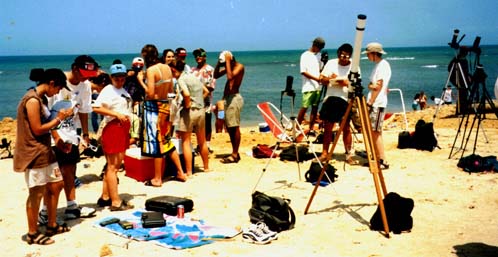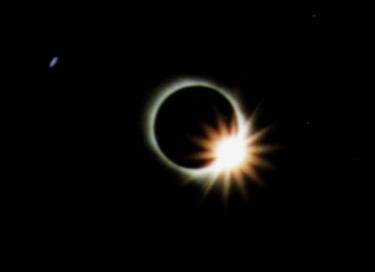|
I was lucky enough to be able to accept a gracious invitation from Colegio Internacional de Caracas
faculty involved with one of the school's eclipse initiatives: a full-blown expedition by IB and
IGCSE science students to the Paraguana Peninsula in order to be in the path of the full eclipse, or
"totality", as they call it. The drive from Caracas to Tiraya, just south of the salt flats of
Falcon, is a long one and although the scenery, which includes the medanos (dunes) outside of Coro,
is at times amazing, it was remarkable that, after the 11 hour trip, 16 road-weary, bus-confined
teenagers were raring to go in their assorted unloading and organizational duties as soon as their
toes hit the sand. Minutes later, photographic and computer data sampling strategies were being
discussed alongside topics such as bedding assignments.
The following morning, the event-specific technical consultations intensified with each passing
hour. That is, of course, until it was time
for the "first wave" of departures to the actual eclipse viewing site, Puerto Escondido, the closest
point to the center of the path of totality reachable by road. This advance crew included CIC Physics
teacher Eric Heim and several students who needed to set up timed experiments starting simultaneously
with those of counterparts in Caracas and elsewhere.
The second, larger, contingent departed
shortly thereafter on the trusty, desert patrol porpuesto with the other dozen students led by CIC
Mathematics teacher Jennifer Kaplan. On site, everyone got down to work quickly. The activites of
members of Mr. Heim's 10th grade Scientific Methods class, such as Suzanna Azevedo, noting
observations of the sun and of peoples' and animals' reactions to it and Robin Ghosh, attempting
to locate and draw a diagram of the 5 classical planets during the period of totality, were
representative of the range of experimentation taking place. Abhijit Rao's mission was to combine
some 25-36 frames into a single, panoramic transition poster. Nicole Perez was hunting some very
specific shots of Jupiter, the chromasphere and Bailey's Beads. ClaireMarie Clark was also
attempting some photographic gymnastics with long exposure shots of the corona and diamond ring
phenomena, as was Maggie O'Donnell with comparative shots from two cameras, one filtered and the
other unfiltered.

11th graders got down to serious projects of their own, like Melissa Nicewarner's
animal observations yielding generalized inversions of nocturnal/diurnal activities by rodents,
reptiles and avians. Eriko Aparcero and 12th grader George Lee measured the light intensity and
ambient temperature (10 degree Celsius drop from noon to totality) and Rebekah Wrobbel worked
aperture priorities for her shots of the stages. Hedison Mui tackled the ambitious job of
recording the stages with binoculars, pencil and pad, while Roberto Roubicek produced a time-lapse
video record. Don Gossen undertook straightforward photography with a unique tripod arrangement
while Christy West produced a video/still shot comparison. 12th graders Yi-Lei Wu and Sarah
Kucera contributed with full-process photography and logistical support, respectively. Mr. Heim
summed up the students' impressions: "...they have no way to understand what they're going to
experience and they'll come away with a life-long experience that's incomparable". Truely.
During the twilight of those 2'50" of totality, these kids really shone.
|
In their own words:
-The International School of Aruba-
ISA worked with 250 scientists during the eclipse. Scientists from NASA, Science Museum of Minnesota
and Exploratiorum (Discovery Channel). We furnished speakers across the island and had 15 scientists
do workshops at ISA for our students. Super Eclipse!
Dr. Jerry C. McGee
Headmaster
-Escuela de Las Americas-
Classes themselves were fully eclipsed in El Tigre where all ELA students were
dismissed to go outside with special devices. Observation was organized by Math teacher Jennifer
Crozier who supervised the recording of temperature differences and the construction of a shoe box
eclipse viewer. Mirrors were also used to project a reflection of the eclipse. Although the sun was
almost 75% covered in El Tigre, the brightness was still substantial.
-Colegio Internacional de Carabobo in Valencia-
Preparation for "Eclipse Day" at Colegio Internacional de Carabobo included science lessons from a 5th grade team, safety lessons from the NHS and the making of carnival-style masks with mylar viewers. A mural was created on the library wall as the eclipse took place. Every elementary student had a secondary buddy and the entire school watched
together as the shadow over the sun approached 93%. It was an experience we will remember forever!
|




